Unlocking Productivity: How ChatGPT Revolutionizes Product Management
Written on
Chapter 1: Understanding ChatGPT's Role in Product Management
If you haven't come across ChatGPT yet, you might be missing out on a transformative tool. ChatGPT is an advanced AI language model that has been trained on a vast dataset, allowing it to generate human-like text and even code based on user prompts. Think of it as a combination of Google, Stack Overflow, Grammarly, and Duolingo in one platform.
This powerful AI can handle a variety of natural language processing tasks, including text summarization, translation, and answering questions. It's already assisting countless professionals in enhancing their productivity, even with complex challenges. Given that Product Management is crucial in many tech firms, I was eager to explore how ChatGPT could support Product Managers in their daily responsibilities.
The examples provided in this article aim to showcase ChatGPT's capabilities. Personally, I view ChatGPT as a game-changer—it's like having your own product mentor, assistant, and brainstorming partner—available at no cost. However, it's crucial to understand that while ChatGPT can assist, it should not replace fundamental activities for Product Managers like understanding customers, markets, and users. Instead, I suggest using ChatGPT for repetitive or cognitively demanding tasks or for a boost when you feel stuck.
To illustrate these points, I have created a hypothetical smartphone application called “FriendFinder”.
Section 1.1: Crafting Product Visions
A product vision is essentially the overarching objective of your product, encapsulating its purpose and the positive impact it aims to make on users' lives. It serves as your guiding principle, directing you and your team through every product-related decision.
Although this concept seems straightforward, articulating a product vision can be quite challenging. There's a wealth of information to include, yet it needs to be inspiring. My initial test for ChatGPT was to see if it could formulate an engaging product vision for my FriendFinder app based on some preliminary details I provided.

I was genuinely impressed with the product vision it crafted, especially given the minimal information I offered. It successfully integrated all necessary details into a single compelling statement.
Verdict: 8/10
Section 1.2: Formulating Product Strategies
A product strategy outlines how your product will realize its vision through a high-level, detailed plan of action. While there are various methods for developing a product strategy, many product professionals typically start by addressing specific questions about their product, target audience, and customer segments.
Similar to product visions, crafting strategies can be demanding due to the extensive research and knowledge required. Thus, I next tested ChatGPT's ability to draft the foundation of a product strategy based on the scant information I provided for the vision.

In this case, ChatGPT generated a fairly comprehensive list of topics expected in a product strategy. It also offered intriguing insights for each area. However, the accuracy of this information is vital. A single erroneous assumption could lead your product astray. It’s essential to emphasize that while ChatGPT can jumpstart your product strategy, it should not be seen as a substitute for a well-informed, collaboratively crafted strategy with stakeholders.
Verdict: 5/10
Chapter 2: Building Effective Product Roadmaps
The video "6 Ways ChatGPT-4o and AI Will Change Product Management Forever" discusses transformative strategies for integrating AI into product management, highlighting practical applications and future implications.
Next, I assessed ChatGPT's capabilities in creating product roadmaps. As expected, it can assist Product Managers in both forming and validating product roadmaps. In my example, I provided minimal information about the product. This is because ChatGPT remembers prior inputs, eliminating the need for repetition. However, experimenting with various prompts can yield improved results.
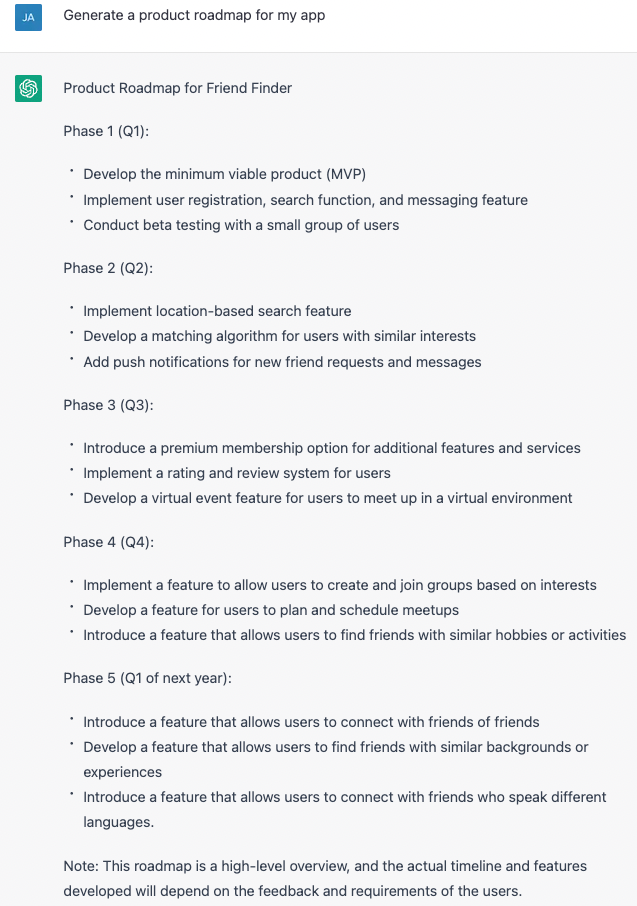
I didn’t specify the available development resources, so naturally, ChatGPT made assumptions about timelines and scope. I found its output to be quite effective, particularly for a product in the early stages. However, for a product already in the market, I’m uncertain how useful this approach would be; perhaps that's a discussion for another time.
Verdict: 7/10 (for new products); 2/10 (for existing products)
Compiling Initial Feature Lists
Once you have a clear vision for your product, creating a list of essential features is a logical next step. This is a standard practice for new products and is especially beneficial for building or validating a product backlog. Such efforts can be time-consuming, making ChatGPT a valuable ally in this process.
ChatGPT efficiently compiled a thorough list of features necessary for my FriendFinder app:
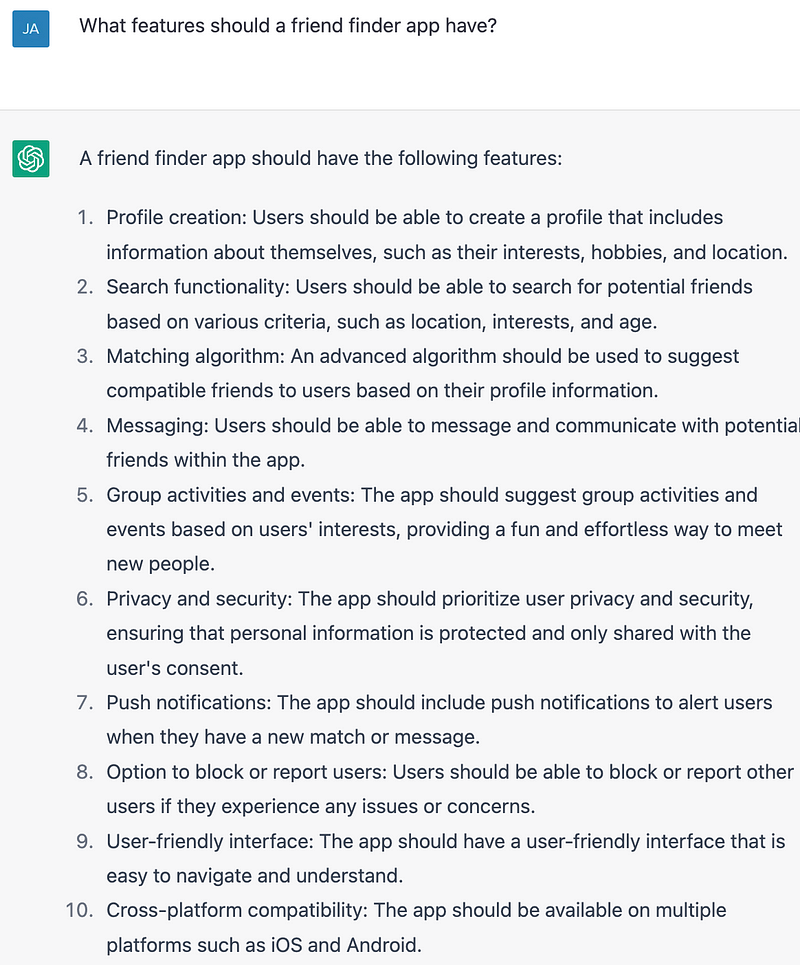
Verdict: 8/10
Product Backlog Items
ChatGPT can also generate detailed product backlog items (PBIs) in the format you need. For instance, I requested it to create a user story for user registration. I've also tested various formats, and ChatGPT excels in all of them.
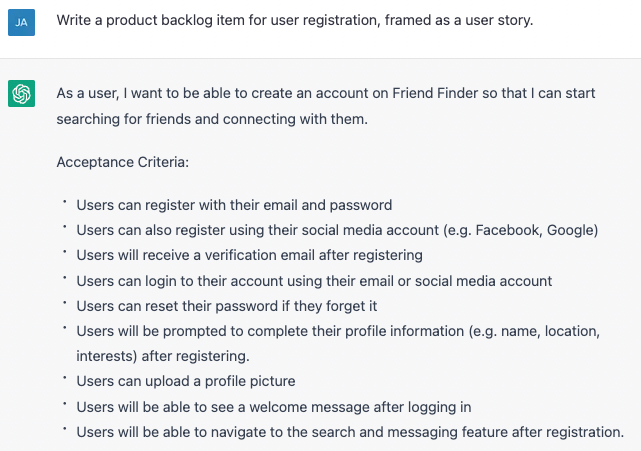
Verdict: 10/10
Splitting User Stories
I was pleasantly surprised by ChatGPT's ability to assist in breaking down large user stories (epics) into smaller, manageable user stories complete with acceptance criteria. This could save significant time, even if some manual adjustments are necessary afterwards.
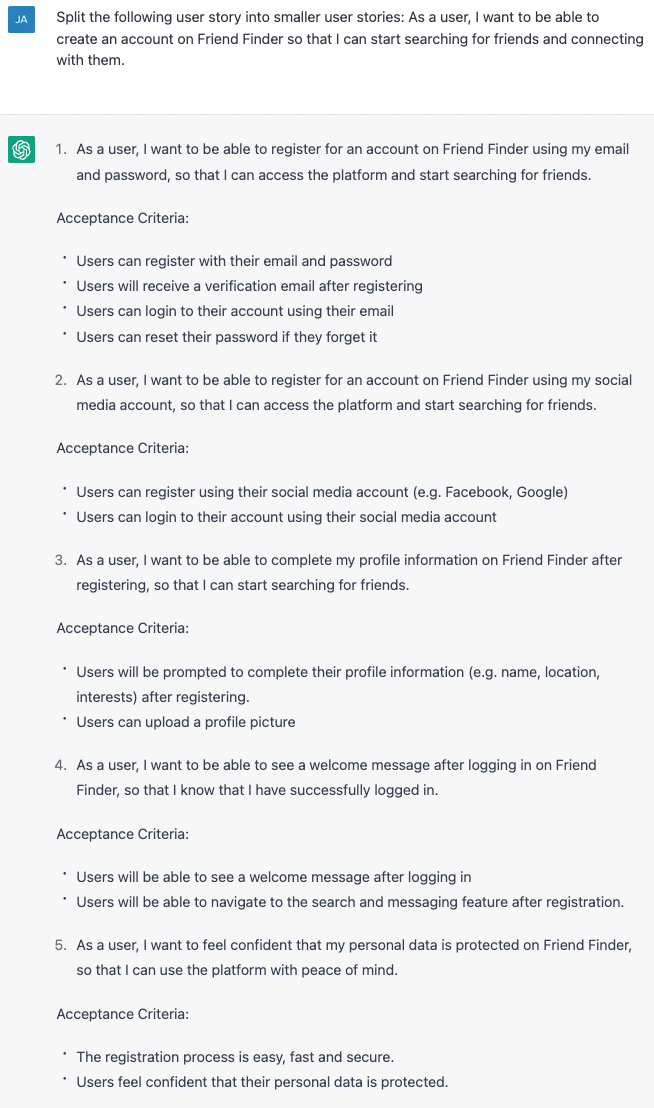
Writing and Communication Aid
Beyond product management-specific tasks, ChatGPT can help with general writing tasks, such as correcting grammar and spelling or rewriting text to sound more polished or confident. Users of tools like Grammarly Premium should take note, as ChatGPT offers similar capabilities and much more.
To illustrate this, consider the paragraph above. Now, observe the transformation when I ask ChatGPT to rewrite it in a more engaging manner.

Another useful feature is its ability to summarize lengthy texts that may require more time to digest or that are overly technical. ChatGPT can rephrase these texts in a more accessible manner.
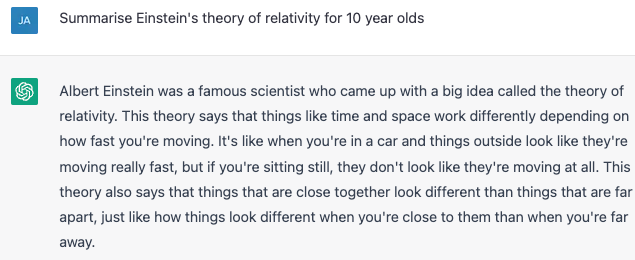
ChatGPT can even draft text for you, such as emails or essays. If you frequently write similar emails, leveraging ChatGPT can save you time and effort. For example:

Conclusion
In summary, ChatGPT emerges as a powerful resource for Product Managers in their everyday tasks. It streamlines repetitive activities like documentation and research while offering valuable insights and learning opportunities. Nonetheless, it's crucial to remember that ChatGPT is a tool—not a substitute for a Product Manager's knowledge and expertise. While it can aid with certain responsibilities, reliance on it should be limited in areas where deep understanding is essential. Product Managers should aim to balance leveraging ChatGPT's benefits while maintaining their own skills and knowledge. With the right approach, ChatGPT can be an invaluable asset for Product Managers navigating today's fast-paced, ever-changing business landscape.
And yes, I did ask ChatGPT to help me craft this conclusion!
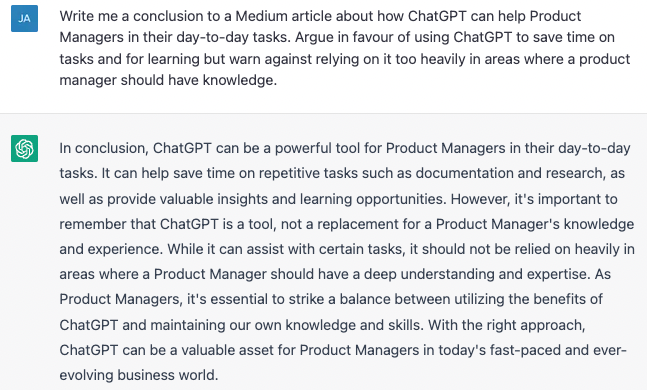
If you found this article helpful, please show your appreciation by clapping!
Follow me for more insights on Product Management!